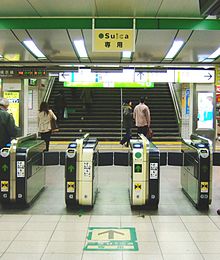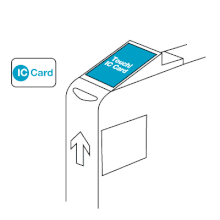Suica

The Suica is a contactless, rechargeable electronic ticket in the form of a credit card-sized chip card that can be used in the Tokyo - Kantō area on the East Japan Railway Company ( JR East ) network in Japan. It was introduced in November 2001, and since June 2003 it can be combined with a credit card issued by JR.
In November 2003, the Suica was used on a trial basis for the first time as an electronic wallet for paying in train station kiosks. This function has now been extended to many other businesses.
The card can be used without contact by simply swiping over a reader. It is not necessary to remove the card from the wallet, which means that payments can be made much faster than with cash. This makes the card popular with customers and retailers alike.
The option of having the transactions made printed out as an overview at a later date also offers a high level of transparency about the payments. The transaction data are stored in a central system under the identification number of the card.
Because of its uncomplicated usability in contrast to the German cash card , the Suica is very popular; in April 2006 there were around 16 million users, although the card has not yet been introduced across the board in Japan.
NTT Docomo , by far the largest mobile phone provider in Japan, has been offering mobile phones with an integrated Suica function since 2006. These also offer the opportunity to check card activity and account balance at any time and to transfer top-ups online.
Initially only valid in local traffic around Tokyo, the Suica was then also introduced in the Shinkansen lines operated by JR East (Tohoku and Joetsu) as well as in the greater Sendai and Niigata areas .
For the greater Osaka area , JR West released the ICOCA IC card in November 2003; since August 2004 it has also been accepted in the JR East area, and accordingly also in Osaka. The expansion to private railways, subways and buses in Osaka and Tokyo is planned gradually for the years after 2005.
The abbreviation Suica stands for "Super Urban Intelligent CArd" (dt. Intelligent city map) and is at the same time a play on words with the Japanese words for "zügig, Leicht" (suisui to, ス イ ス イ と) and "Karte" (kaado, カ ー ド) , thus "suika" (ス イ カ), which is the Japanese word for watermelon . The letters "ic" are highlighted to emphasize the chip card technology.
The card can be purchased for 1,000 yen at Midori no Madoguchi counters or ticket machines. The price includes a deposit of 500 yen, which will be refunded when the card is returned. The remaining 500 yen can be used for rail travel. You can top up up to 20,000 yen at selected ticket machines. The credit can be checked there and a record of the travel expenses can also be printed out.
There are two types of Suica, a Suica-IO card, which is used as a ticket substitute for train journeys, and a commuter card, which is used to travel between two locations (for example, home - work or school). The commuter card can also be used as a normal Suica IO card.
The card contains an RFID (radio frequency identification) chip, which was developed by Sony under the name Felica . The same technology is still used for the following transport associations:
- Atlanta : Breeze Card for MARTA
- Hong Kong : Octopus card for the MTR and retail
- Kaohsiung : easycard for KMRT
- Singapore : EZ-link Card for the MRT (Singapore)
Individual evidence
- ↑ http://www.aptastandards.com/LinkClick.aspx?fileticket=akrT-ZOKmKk%3D&tabid=278&mid=1437&language=en-US
Web links
- JR 東 日本 : Suica (Japanese)
- Sony Global - FeliCa Web Site
